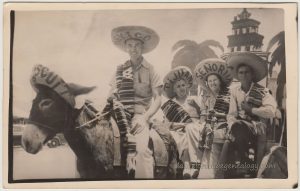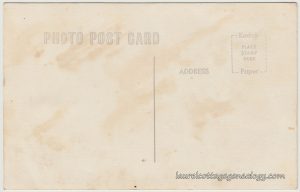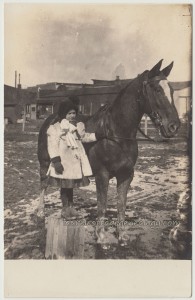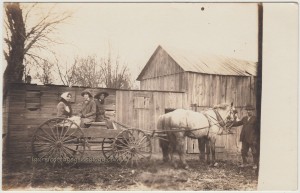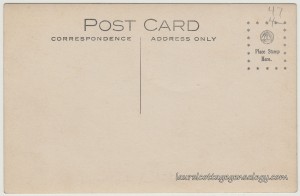Divided back, used postcard. Circa 1949. Artist unknown. Publisher: Fischgrund, Mexico (Eugenio Fischgrund). Printed in Mexico. Printer: F. Sanchez H. y Cia, México, D.F. (Mexico City).
Price: $20.00
Color! If you’ve been looking at the last number of black and white posts, this is a heavenly change (adore those black and white ones though!)
A postcard, circa 1949, from an unknown artist’s painting, showing a market scene in the city of Cuernavaca, Mexico. Cuernavaca is the capital of the Mexican state, Morelos, and located south of Mexico City. That looks like a depiction of the Cathedral of the Assumption of Mary (Catedral de la Asunción de María) in the background. And closer in the scene we see part of a building bearing the sign “Así es la Vida” translated as “such is life.” Maybe a restaurant or a bar? (There is a Phoenix AZ restaurant by this name.) The senders wrote:
“Ramon, Estubimos (estuvimos) haber los toros vimos a tu suegra, Elisia y Frank pero no tubimos (tuvimos) chansa de hablar con ellos. Mañana saldremos para otra parte. tus padres Dámaso y Josefa.”
Translation: “We saw the bulls and were with your mother-in-law, Elisia and Frank but we did not have a chance to talk with them. We’re leaving tomorrow, your parents Dámaso and Josefa.”
Addressed to: “Mr. Ramon Diaz, Alvarado, California, U. F. of America.”
I think the senders were saying “United Federation” of America and obviously meant U. S. of A. As for the postmark, that looks like 49 for year 1949.
The town of Alvarado was located in Alvarado County and does not exist in present-day, it was annexed to Union City in 1959.
The 1930 U. S. Federal Census finds the Diaz family living in Washington Township, Alameda County, California: Damaso Diaz, born Spain about 1888, occupation meat salesman; his wife Josephine, born Spain about 1886; son Segundo, born Hawaii about 1914; son Cipriano, born California about 1915; daughter Mary, born California about 1916; and our postcard addressee, Raymond, born California about 1920.
The 1940 Federal Census for the family was found also (spelled Dias), showing that by now Damaso is the owner of a grocery and meat market, daughter Mary is married to Frank Vargas, Segundo is a delivery man for his dad, Cipriano Diaz and Frank Vargas are salt workers, and Raymond is helping his dad at the store.
Looking a little further we find Raymond was born in 1919, served in WWII, enlisted as a private and was promoted to sergeant, and (assuming he was married once) he married Beatrice (maiden name unknown) sometime between 1942 – 1949. In ’42 his occupation was welder. In 1959 he and his wife were living in Union City and he was working as a barber. He died in 1995 and is buried in the San Joaquin National Cemetery in Santa Nella. (Funny, I’ve driven by this cemetery a number of times when we lived in the Central Valley.)
I’m struck again by the feeling that these postcards, photos, trade cards etc. are like doorways (chuckling but serious) containing glimpses of so many connected stories: This particular Diaz family has origins in Spain, they were in Hawaii when their oldest son was born, but put they down roots in California. The parents vacationed near Mexico City. The now defunct town of Alvarado was known for sugar beets. The postcard publisher lived in Mexico but was born in what is now the Czech Republic (we’ll have to get a post up on him later) and we could go on and on.
Sources: Alvarado, California. n.d. https://en.wikipedia.org/wiki/Alvarado,_California (accessed April 30, 2016).
Year: 1930; Census Place: Washington, Alameda, California; Roll: 112; Page: 4A; Enumeration District: 0343; Image: 189.0; FHL microfilm: 2339847. (Ancestry.com)
“United States Census, 1940,” database with images, FamilySearch (https://familysearch.org/ark:/61903/1:1:K9QW-WDS : accessed 30 April 2016), Raymond Dias in household of Damaso Dias, Washington Judicial Township, Alameda, California, United States; citing enumeration district (ED) 1-178, sheet 4B, family 99, NARA digital publication T627 (Washington, D.C.: National Archives and Records Administration, 2012), roll 191.
National Archives and Records Administration. U.S. World War II Army Enlistment Records, 1938-1946. (Ancestry.com)
Original data: Find A Grave. Find A Grave. Memorial #580002. http://www.findagrave.com/cgi-bin/fg.cgi.
Polk’s San Leandro (Alameda County) City Directory 1959. p. 263. (Ancestry.com. U.S. City Directories, 1822-1995)





